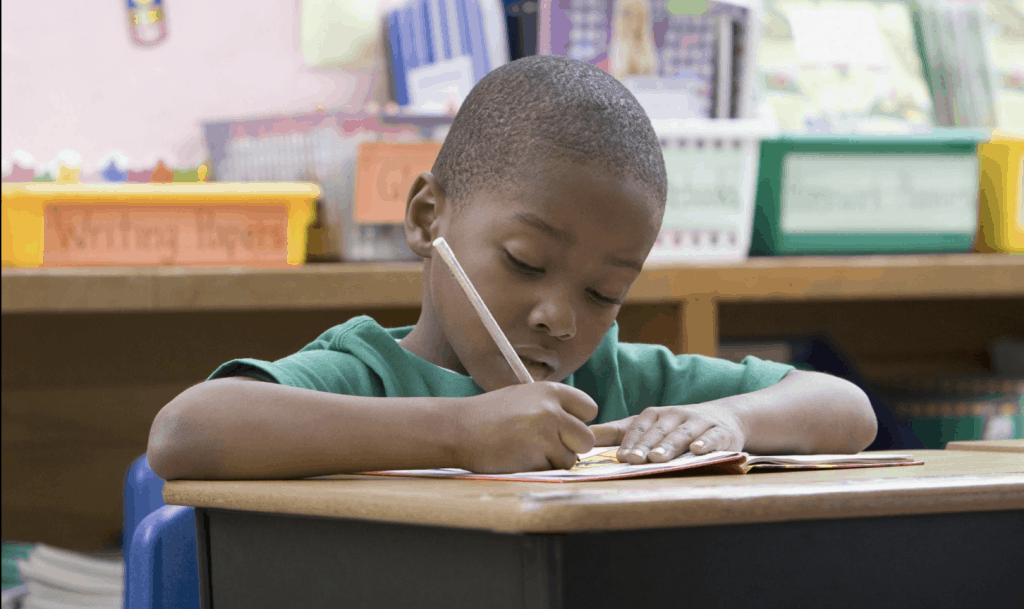Now more than ever before, literacy is an essential skill for functioning in our society. From computer screens to road signs, from restaurant menus to text messages, the ability to read affects nearly every aspect of our lives. Unfortunately, about 40% of all adults in the United States lack the reading skills needed to thrive at work and at home.[1]
One of the most common reading disorders is dyslexia, which affects roughly one in five students.[2] Odds are, you’ll have at least one or two students in your class who struggle with this disorder each year. Since students with dyslexia develop better reading skills if they’re provided treatment early on, learning how to recognize dyslexia symptoms and support these students can have a lasting impact.
Want to be better prepared to meet the needs of students with dyslexia in your class? Learn what dyslexia is, why it develops, and which symptoms to look for in children. Then, discover five tips for teaching and providing accommodations for students with dyslexia.
What Does Dyslexia Mean and How Does It Affect Learning?
 Understanding what the definition of dyslexia is and is not can help educators best meet their students’ needs. According to the International Dyslexia Association, the definition of dyslexia is a learning disability that causes problems with phonological awareness, spelling, and word recognition.[3] While the medical field uses the term “dyslexia,” some educators prefer to call it specific reading disability to avoid labels.[4] This is because in the educational field, there are a lot of misconceptions surrounding dyslexia.
Understanding what the definition of dyslexia is and is not can help educators best meet their students’ needs. According to the International Dyslexia Association, the definition of dyslexia is a learning disability that causes problems with phonological awareness, spelling, and word recognition.[3] While the medical field uses the term “dyslexia,” some educators prefer to call it specific reading disability to avoid labels.[4] This is because in the educational field, there are a lot of misconceptions surrounding dyslexia.
For example, many teachers assume that dyslexia is a visual processing disorder. Despite popular belief, however, dyslexia is actually a language-based learning disability.[5] This means that dyslexia isn’t a problem with a student’s eyes–their brains have trouble connecting print letters to sounds. This is why when a child is diagnosed with dyslexia, we send them to a reading specialist rather than an optometrist.
Dyslexia symptoms can vary from student to student–some might see words as warped or jumbled up while others might not be able to tell the difference between similar looking letters. Of all forms of dyslexia, English is a particularly different language for these students to learn to read in–regardless of native tongue–because the relationship between sounds and letters isn’t always predictable.[6] For this reason, students learning to read in English may feel even more frustrated than those learning literacy in other languages.
The Factors that Cause Dyslexia in Children
Like many learning disorders, dyslexia isn’t usually caused by one specific thing but a variety of complex factors.[7] The more educators study dyslexia, the more they’ve realized just how complicated developing the disorder is. While these factors are still being researched, experts have narrowed down a few key areas.
Is dyslexia genetic or hereditary? It seems that dyslexia can be hereditary, but the exact relationship between this reading disorder and our genes isn’t yet clear.[8] Because dyslexia can run in families, clinicians often ask if any relatives have been diagnosed with dyslexia when they’re evaluating a student. But as for a specific gene or set of genes, researchers have not yet pinpointed a cause. And because many students diagnosed with dyslexia don’t have a family history of it, the connection between genetics and reading difficulties is even less clear.
 There also appears to be a connection between dyslexia and neuroscience. Researchers have found that students with dyslexia have lower levels of activation in the parts of the brain associated with reading.[9] What this suggests, however, isn’t that these students don’t try hard enough but that the brain functions that contribute to literacy might be underdeveloped. Their brains might try to compensate by using different areas to read but are unable to decode letters in quite the same way.[10]
There also appears to be a connection between dyslexia and neuroscience. Researchers have found that students with dyslexia have lower levels of activation in the parts of the brain associated with reading.[9] What this suggests, however, isn’t that these students don’t try hard enough but that the brain functions that contribute to literacy might be underdeveloped. Their brains might try to compensate by using different areas to read but are unable to decode letters in quite the same way.[10]
What researchers know for certain is that dyslexia develops early in a child’s life. Early signs of reading disorders can occur as early as 2 ½ years old.[11] In PreK, children with dyslexia often already have difficulties with letter-sound recognition, phonemic awareness, and vocabulary.[12] Those who study the causes of learning disabilities also believe that dyslexia is chronic, not temporary. This means that while treatment can help these students turn their weaknesses into strengths, the symptoms they experience don’t always go away.[13]
Is Dyslexia a Disability? Rethinking Reading Disorders
Is dyslexia a learning disability that limits a student’s potential? While dyslexia is considered a reading disorder, it in no way determines a student’s IQ or academic ability.[14] Students with dyslexia do have different needs than other students when learning to read, and they may have distinct strengths or weaknesses. But these students are just as capable of not only reading but achieving just as much as their peers.
In fact, plenty of people diagnosed with dyslexia have been able to lead fulfilling and successful lives. A few famous people with dyslexia include:[15]
- Scientists: Albert Einstein, Elizabeth Blackburn, Ann Bancroft
- Artists: Walt Disney, Sally Gardner, Ansel Adams
- Writers: Hans Christian Andersen, Agatha Christie, F. Scott Fitzgerald
- Actors: Whoopi Goldberg, Keira Knightley, Robin Williams
- Entrepreneurs: Steve Jobs, Henry Ford, Tommy Hilfiger
Does anything surprise you about this list? Maybe you weren’t expecting notable writers to have been diagnosed with a reading disorder. Or maybe you didn’t think that Albert Einstein, who many believe to be the smartest person who ever lived, would make the list of famous people with dyslexia. Dyslexia doesn’t prevent a student from achieving their dreams and making a difference in the world. As educators, having a positive mindset about how to teach these students can help prepare them for academic success.
But that being said, if dyslexia significantly impairs a student’s literacy acquisition, dyslexia is considered a learning disability under the Individuals with Disabilities Education Improvement Act (IDEA).[16] This means that your student could be eligible for accommodations through a school’s specialists or accessibility centers. If you have a student with dyslexia in your class, talk with your colleagues or administrators about dyslexia accommodations.
For Educators: How to Recognize Early Signs of Dyslexia in Children
Dyslexia symptoms in children can vary in severity depending on the person, so no two students’ needs are alike.[17] Like many learning disorders, the characteristics of dyslexia exist on a spectrum. But while every child is different, there are some common traits you can look for to spot dyslexia in the classroom.
What are the symptoms of dyslexia? Although only a professional can officially diagnose a child with a reading disorder, here are a few symptoms of dyslexia to watch for:
- Cannot read sentences smoothly–may skip or swap out unfamiliar words [18]
- Does not associate print letters with sounds [19]
- Uncomfortable reading words sentences out loud [20]
- Confuses letters that look similar (e.g. “d” and “b”) [21]
- Reading ability does not match their overall intelligence [22]
Students with dyslexia are also more likely to have trouble focusing in class because reading is more difficult for them.[8] For this reason, some children who have dyslexia are misdiagnosed as having attention-deficit hyperactivity disorder (ADHD). Although students can have both ADHD and dyslexia, these two disorders benefit from distinct treatments. If you notice that a student has trouble paying attention in class, try referring them to a specialist for a proper diagnosis.
Because dyslexia can be hereditary, it could help to ask a child’s parents if they or any of their relatives have received a diagnosis.[23] If their student displays any warning signs of dyslexia, they could be more prepared to offer support. Even if dyslexia doesn’t run in a child’s family, however, discussing the possibility with their parents may encourage them to seek an official diagnosis. The sooner a child receives help, the faster they’ll be able to catch up with their peers.[24]
Guided Reading Activities for Students with Dyslexia
Many teachers feel that while they know how to teach early reading skills, they don’t know how to best reach children with dyslexia.[25] But luckily, with the right learning strategies for students with dyslexia, you can help every child in your classroom thrive and develop strong reading skills.
Use these five activities, teaching strategies, and accommodations for dyslexia to help struggling students learn to read:
- Try engaging all of the student’s senses when teaching them to read, like giving them magnet letters to put together words. Multisensory activities are shown to significantly help students with dyslexia develop literacy [26]
- Help students with dyslexia access resources like audiobooks, dictation programs, or spell-checking software [27]
- Encouragement can help students who have dyslexia find the confidence they need to succeed in school. Give your students praise when they master a challenging skill and celebrate milestones they reach along the path to literacy
- Set mutually agreed-upon reading goals with children diagnosed with dyslexia to promote student engagement [28]
- Some students with reading difficulties may need extra help outside of the classroom. Refer students to remediation or learning disorder specialists, if needed [29]
Sources:
Thomson, J. Good Practice in interventions for teaching dyslexic learners and in teacher training in English‐speaking countries. Harvard Graduate School of Education, July 2010, pp. 1-13.[1]
Washburn, E.K., Joshi, R.M., and Binks-Cantrell, E.S. Teacher knowledge of basic language concepts and dyslexia. Dyslexia: An International Journal of Research and Practice, May 2011, 17(2), pp. 165-83.[2]
International Dyslexia Association. IDA Dyslexia Handbook: What Every Family Should Know. Retrieved from readingrockets.org: http://www.readingrockets.org/sites/default/files/IDA%20Dyslexia%20Handbook.pdf.[3]
Thomson, J. Good Practice in interventions for teaching dyslexic learners and in teacher training in English‐speaking countries. Harvard Graduate School of Education, July 2010, pp. 1-13.[4]
Washburn, E.K., Joshi, R.M., and Binks-Cantrell, E.S. Teacher knowledge of basic language concepts and dyslexia. Dyslexia: An International Journal of Research and Practice, May 2011, 17(2), pp. 165-83.[5]
Thomson, J. Good Practice in interventions for teaching dyslexic learners and in teacher training in English‐speaking countries. Harvard Graduate School of Education, July 2010, pp. 1-13.[6]
Ibid.[7]
International Dyslexia Association. IDA Dyslexia Handbook: What Every Family Should Know. Retrieved from readingrockets.org: http://www.readingrockets.org/sites/default/files/IDA%20Dyslexia%20Handbook.pdf.[8]
Shaywitz, B.A., Shaywitz, S.E., Pugh, K.R., Mencl, W.E., Fulbright, R.K., and Skudlarksi, P. Disruption of posterior brain systems for reading in children with developmental dyslexia. Biological Psychiatry, 2002, 52, pp. 101-110.[9]
Ibid.[10]
Scarborough, H.S. Very Early Language Deficits in Dyslexic Children. Child Development, December 1990, 61(6), pp. 1728-43.[11]
Ibid.[12]
Aylward, E.H., Richards, T.L., Berninger, V.W., Nagy, W.E., Field, K.M., and Grimme, A.C. Instructional treatment associated with changes in brain activation in children with dyslexia. Neurology, 2003, 61, pp. 212-219.[13]
International Dyslexia Association. IDA Dyslexia Handbook: What Every Family Should Know. Retrieved from readingrockets.org: http://www.readingrockets.org/sites/default/files/IDA%20Dyslexia%20Handbook.pdf.[14]
Davis Dyslexia Association. List of Dyslexic Achievers. Retrieved from dyslexia.com: https://www.dyslexia.com/about-dyslexia/dyslexic-achievers/all-achievers/.[15]
Individuals With Disabilities Education Act, 20 U.S.C. § 1400, 2004.[16]
Sahari, S.H., and Johari, A. Improvising Reading Classes and Classroom Environment for Children with Reading Difficulties and Dyslexia Symptoms. Procedia: Social and Behavioral Sciences, 2012, 38, pp. 100-107.[17]
Learning Ally. Hidden in Plain Sight: Seven Common Signs of Dyslexia in the Classroom. Retrieved from learningally.org: https://www.learningally.org/Portals/6/Docs/white-papers/HiddeninPlainSight_WP_o.pdf.[18]
Yale Center for Dyslexia & Creativity. Signs of Dyslexia. Retrieved from yale.edu: https://dyslexia.yale.edu/dyslexia/signs-of-dyslexia/.[19]
ibid.[20]
The Understood Team. Dyslexia Symptoms in Children. Retrieved from understood.org: https://www.understood.org/en/learning-attention-issues/signs-symptoms/could-your-child-have/checklist-signs-of-dyslexia-at-different-ages.[21]
Learning Ally. Hidden in Plain Sight: Seven Common Signs of Dyslexia in the Classroom. Retrieved from learningally.org: https://www.learningally.org/Portals/6/Docs/white-papers/HiddeninPlainSight_WP_o.pdf.[22]
International Dyslexia Association. IDA Dyslexia Handbook: What Every Family Should Know. Retrieved from readingrockets.org: http://www.readingrockets.org/sites/default/files/IDA%20Dyslexia%20Handbook.pdf.[23]
Torgesen, J.K. Individual differences in response to early interventions in reading: The lingering problem of treatment resisters. Learning Disabilities Research & Practice, 2000, 15, pp. 55-64.[24]
Washburn, E.K., Joshi, R.M., and Binks-Cantrell, E.S. Teacher knowledge of basic language concepts and dyslexia. Dyslexia: An International Journal of Research and Practice, May 2011, 17(2), pp. 165-83.[25]
Learning Ally. Hidden in Plain Sight: Seven Common Signs of Dyslexia in the Classroom. Retrieved from learningally.org: https://www.learningally.org/Portals/6/Docs/white-papers/HiddeninPlainSight_WP_o.pdf.[26]
Yale Center for Dyslexia & Creativity. Tips from Students. Retrieved from yale.edu: https://dyslexia.yale.edu/resources/dyslexic-kids-adults/tips-from-students/.[27]
Thomson, J. Good Practice in interventions for teaching dyslexic learners and in teacher training in English‐speaking countries. Harvard Graduate School of Education, July 2010, pp. 1-13.[28]
International Dyslexia Association. IDA Dyslexia Handbook: What Every Family Should Know. Retrieved from readingrockets.org: http://www.readingrockets.org/sites/default/files/IDA%20Dyslexia%20Handbook.pdf.[29]

